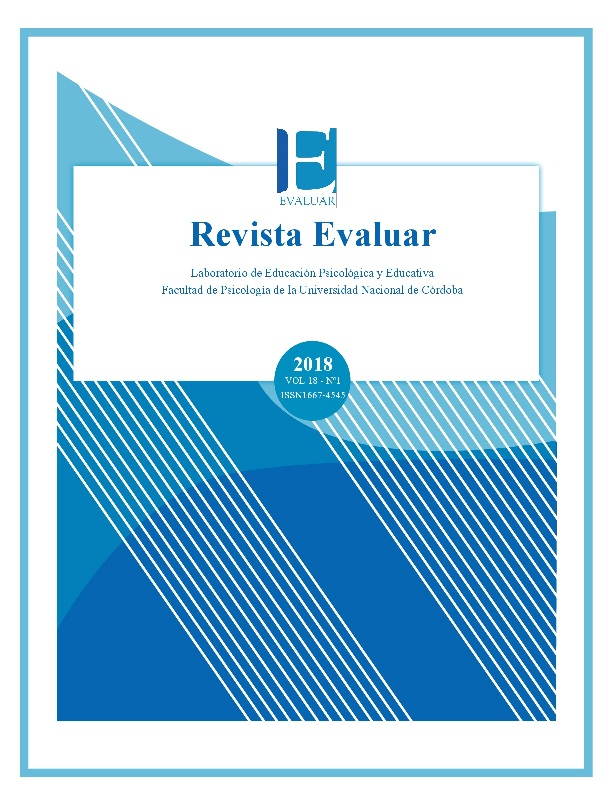Psychometric Properties of the Peer School Victimization Scale (VE-I)
DOI:
https://doi.org/10.35670/1667-4545.v18.n1.19768Keywords:
school victimization, peer victimization, adolescence, scale, psychometric propertiesAbstract
School violence among peers has serious consequences for the victims. Victimization can be direct, through physical and verbal aggression, and relational, through exclusion and social rejection. The objective of this study was
to analyze the psychometric properties of the Peer School Victimization Scale (VE-I), which consists of 11 items related to different forms of victimization. 1389 adolescents (50.45% boys) ranging from 11 to 15 years old (M = 13.37, SD = 1.23) participated in this study. The structure of the scale was analyzed by means of exploratory factor analysis and confirmatory factor analysis using two different subsamples. The results show the existence of three factors (physical victimization, verbal victimization and relational victimization), with reliability coefficients higher than ? = .70 and negative correlations with social self-concept and life satisfaction. The analyzed scale has adequate psychometric properties and can be useful in research and interventions
about this topic.
Downloads
References
Atienza, F. L., Pons, D., Balaguer, I., & García-Merita, M. (2000). Propiedades psicométricas de la Escala de Satisfacción con la Vida en adolescentes. Psicothema, 12(2), 314-320. Recuperado de http://www.psicothema.com
Bentler, P. M. (2007). On tests and indices for evaluating structural models. Personality and Individual Differences, 42(5), 825-829. doi: 10.1016/j.paid.2006.09.024
Bentler, P. M., & Bonett, D. G. (1980). Significance tests and goodness of fit in the analysis of covariance structures. Psychological Bulletin, 88(3), 588-606. doi: 10.1037/0033-2909.88.3.588
Bradshaw, J., Crous, G., Rees, G., & Turner, N. (2017). Comparing children’s experiences of school-based bullying across countries. Children and Youth Ser-vices Review, 80, 171-180. doi: 10.1016/j.childyou-th.2017.06.060
Buelga, S., Cava, M. J., & Musitu, G. (2012). Reputación social, ajuste psicosocial y victimización entre adolescentes en el contexto escolar. Anales de Psicología, 28(1), 180-187. Recuperado de http://revistas.um.es/analesps/index
Buelga, S., Martínez-Ferrer, B., & Cava, M. J. (2017). Differences in family climate and family communication among cyberbullies, cybervictims, and cyber bully-victims in adolescents. Computers in Human Behavior, 76, 164-173. doi: 10.1016/j.chb.2017.07.017
Card, N. A., & Hodges, E. V. E. (2008). Peer victimization among schoolchildren: Correlations, causes, consequences, and considerations in assessment and intervention. School Psychology Quarterly, 23(4), 451-461. doi: 10.1037/a0012769
Carrascosa, L., Cava, M. J., & Buelga, S. (2018). Programa DARSI: Desarrollando en Adolescentes Relaciones Saludables e Igualitarias. Valencia: Palmero.
Cava, M. J. (2011). Familia, profesorado e iguales: Claves para el apoyo a las víctimas de acoso escolar. Psychosocial Intervention, 20(2), 183-192. doi: 10.5093/in2011v20n2a6
Cava, M. J., Buelga, S., Musitu, G., & Murgui, S. (2010). Violencia escolar entre adolescentes y sus implicaciones en el ajuste psicosocial: Un estudio longitudinal. Revista de Psicodidáctica, 15(1), 21-34. Recuperado de http://www.ehu.eus/ojs/index.php/psicodidactica/index
Cava, M. J., Musitu, G., Buelga, S., & Murgui, S. (2010). The relationships of family and classroom environments with peer relational victimization: An analysis of their gender differences. The Spanish Journal of Psychology, 13(1), 156-165. doi: 10.1017/S1138741600003747
Cava, M. J., Musitu, G., & Murgui, S. (2007). Individual and social risk factors related to victimization in a sample of Spanish adolescents. Psychological Reports, 101(1), 275-290. doi: 10.2466/pr0.101.1.275-290
Cerezo, F., Calvo, A. R., & Sánchez, C. (2011). Programa CIP. Intervención psicoeducativa y tratamiento diferenciado del bullying. Concienciar, Informar y Prevenir. Madrid, España: Pirámide.
Cohen, J. (1988). Statistical power analysis for the behavioral sciences (2ª ed.). Hillsdale, NJ, Estados Unidos: Lawrence Erlbaum Associates.
Crick, N. R., & Grotpeter, J. K. (1996). Children’s treatment by peers: Victims of relational and overt aggression. Development and Psychopathology, 8(2), 367-380. doi: 10.1017/S0954579400007148
Declaración de Helsinki (2008). Principios éticos para las investigaciones médicas en seres humanos. Declaración aprobada en la 59ª Asamblea General de la Asociación, celebrada en Seúl, Corea. http://bvs.sld.cu/revistas/recursos/helsinki.pdf
Del Barrio, C., Martín, E., Montero, I., Gutiérrez, H., Barrios, A., & De Dios, M. J. (2008). Bullying and social exclusion in Spanish secondary schools: National trends from 1999 to 2006. International Journal of Clinical and Health Psychology, 8(3), 657-677. Recuperado de http://www.aepc.es/ijchp/indizacion.php?coid=Espa%EF%BF%BDol
Del Rey, R., & Ortega, R. (2008). Bullying in poor countries: Prevalence and coexistence with other forms of violence. International Journal of Psychology and Psychological Therapy, 8(1), 39-50. Recuperado de http://www.ijpsy.com/
Diener, E., Emmons, R., Larsen, R. J., & Griffin, S. (1985). The Satisfaction with Life Scale. Journal of Personality Assessment, 49(1), 71-75. doi: 10.1207/s15327752jpa4901_13
Estévez, E., Jiménez, T. I., & Cava, M. J. (2016). A cross-cultural study in Spain and Mexico on school aggression in adolescence: Examining the role of individual, family and school variables. Cross-Cultural Research, 50(2), 123-153. doi: 10.1177/1069397115625637
Estévez, E., Jiménez, T. I., & Moreno, D. (2010). Cuando las víctimas de violencia escolar se convierten en agresores: “¿Quién va a defenderme?”. European Journal of Education and Psychology, 3(2), 177-186. doi: 10.30552/ejep.v3i2.40
Estévez-López, E., Martínez-Ferrer, B., & Musitu-Ochoa, G. (2006). La autoestima en adolescentes agresores y víctimas en la escuela: La perspectiva multidimensional. Psychosocial Intervention, 15(2), 223-232. Recuperado de http://scielo.isciii.es/scielo.php?s-cript=sci_serial&pid=1132-0559&lng=es&nrm=iso
Garaigordobil, M., & Martínez-Valderrey, V. (2014). Efecto del Cyberprogram 2.0 sobre la reducción de la victimización y la mejora de la competencia social en la adolescencia. Revista de Psicodidáctica, 19(2), 289-305. doi: 10.1387/RevPsicodidact.10239
García, F., & Musitu, G. (1999). AF5: Autoconcepto Forma 5. Madrid, España: TEA Ediciones.
Gradinger, P., Yanagida, T., Strohmeier, D., & Spiel, C. (2016). Effectiveness and sustainability of the ViSC Social Competence Program to prevent cyberbullying and cyber-victimization: Class and individual level moderators. Aggressive Behavior, 42(2), 181-193. doi: 10.1002/ab.21631
Guhn, M., Schonert-Reichl, K. A., Gadermann, A. M., Hy-mel, S., & Hertzman, C. (2013). A population study of victimization, relationships, and well-being in middle childhood. Journal of Happiness Studies, 14(5), 1529-1541. doi: 10.1007/s10902-012-9393-8
Hair, J. F. Jr., Black, W. C., Babin, B. J., & Anderson, R. E. (2010). Multivariate data analysis (7ª ed.). Upper Saddle River, NJ, Estados Unidos: Prentice Hall.
IBM Corp. (2016). IBM SPSS Statistics for Windows, Version 24.0 [software de cómputo]. Armonk, NY: IBM Corp.
Izquierdo, I., Olea, J., & Abad, F. J. (2014). Exploratory factor analysis in validation studies: Uses and recommendations. Psicothema, 26(3), 395-400. Recuperado de http://www.psicothema.com
Jiménez, T. I., Musitu, G., Ramos, M. J., & Murgui, S. (2009). Community involvement and victimization at school: An analysis through family, personal and social adjustment. The Journal of Community Psychology, 37(8), 959-974. doi: 10.1002/jcop.20342
Kärnä, A., Voeten, M., Little, T. D., Alanen, E., Poskiparta, E., & Salmivalli, C. (2013). Effectiveness of the KiVa antibullying program: Grades 1-3 and 7-9. Journal of Educational Psychology, 105(2), 535-551. doi: 10.1037/a0030417
Kerr, J. C., Valois, R. F., Huebner, E. S., & Drane, J. W. (2011). Life satisfaction and peer victimization among USA public high school adolescents. Child Indicators Research, 4(1), 127-144. doi: 10.1007/s12187-010-9078-y
Kljakovic, M., & Hunt, C. (2016). A meta-analysis of predictors of bullying and victimisation in adolescence. Journal of Adolescence, 49, 134-145. doi: 10.1016/j.adolescence.2016.03.002
Kowalski, R. M., & Limber, S. P. (2013). Psychological, physical, and academic correlates of cyberbullying and traditional bullying. Journal of Adolescent Health, 53(1), S13-S20. doi: 10.1016/j.jadoheal-th.2012.09.018
Markland, D. (2007). The golden rule in that there are no golden rules: A commentary on Paul Barrett’s recommendations for reporting model fit in structural equation modelling. Personality and Individual Differences, 42(5), 851-858. doi: 10.1016/j.paid.2006.09.023
Mehari, K. R., & Farrell, A. D. (2015). The relation between peer victimization and adolescents’ well-being: The moderating role of ethnicity within context. Journal of Research on Adolescence, 25(1), 118-134. doi: 10.1111/jora.12095
Muthén, B. O., & Muthén, L. K. (2010). Mplus User’s Guide (6ª ed.). Los Ángeles, CA, Estados Unidos: Muthén & Muthén.
Mynard, H., & Joseph, S. (2000). Development of the multidimensional peer-victimization scale. Aggressive Behavior, 26(2), 169-178. doi: 10.1002/(SICI)1098-2337(2000)26:2%-3C169::AID-AB3%3E3.0.CO;2-A
Ortega-Baron, J. (2018). Prevención del acoso en adolescentes a través de las nuevas tecnologías de la información y de la comunicación: Programa Preva@cib (Tesis Doctoral no publicada). Universidad de Valencia, España. Resumen disponible en https://dialnet.unirioja.es/servlet/tesis?codigo=137828
Ortega-Barón, J., Buelga, S., Cava, M. J., & Torralba, E. (2017). Violencia escolar y actitud hacia la autoridad de estudiantes agresores de cyberbullying. Revista de Psicodidáctica, 22(1), 23-28.
Ostrov, J. M., & Kamper, K. E. (2015). Future directions for research on the development of relational and physical peer victimization. Journal of Clinical Child & Adolescent Psychology, 44(3), 509-519. doi: 10.1080/15374416.2015.1012723
Palladino, B. E., Nocentini, A., & Menesini, E. (2016). Evidence‐based intervention against bullying and cy-berbullying: Evaluation of the NoTrap! program in two independent trials. Aggressive Behavior, 42(2), 194-206. doi: 10.1002/ab.21636
Pouwels, J. L., Souren, P. M., Lansu, T. A. M., & Cillessen A. H. N. (2016). Stability of peer victimization: A meta-analysis of longitudinal research. Developmental Review, 40, 1-24. doi: 10.1016/j.dr.2016.01.001
Povedano, A., Cava, M. J., Monreal, M. C., Varela, R., & Musitu, G. (2015). Victimization, loneliness, overt and relational violence at the school from a gender perspective. International Journal of Clinical and Health Psychology, 15(1), 44-51. doi: 10.1016/j.ij-chp.2014.09.001https://revistas.unc.edu.ar/index.php/revaluar/index
Proctor, C. L., Linley, P. A., & Maltby, J. (2009). Youth life satisfaction: A review of the literature. Journal of Happiness Studies, 10(5), 583-630. doi: 10.1007/s10902-008-9110-9
Reijntjes, A., Kamphuis, J. H., Prinzie, P., & Telch, M. J. (2010). Peer victimization and internalizing problems in children: A meta-analysis of longitudinal studies. Child Abuse & Neglect, 34(4), 244-252. doi: 10.1016/j.chiabus.2009.07.009
Thompson, R. S. Y., & Leadbeater, B. J. (2013). Peer victimization and internalizing symptoms from adolescence into young adulthood: Building strength through emotional support. Journal of Research on Adolescence, 23(2), 290-303. doi: 10.1111/j.1532-7795.2012.00827.x
Troop-Gordon, W. (2017). Peer victimization in adolescen-ce: The nature, progression, and consequences of being bullied within a developmental context. Journal of Adolescence, 55, 116-128. doi: 10.1016/j.adoles-cence.2016.12.012
Worthington, R. L., & Whittaker, T. A. (2006). Scale development research. A content analysis and recommendations for best practices. The Counseling Psychologist, 34(6), 806-838. doi: 10.1177/0011000006288127
Wu, L., Zhang, D., Su, Z., & Hu, T. (2015). Peer victimization among children and adolescents: A meta-analytic review of links to emotional maladjustment. Clinical Pediatrics, 54(10), 941-955. doi: 10.1177/0009922814567873
Downloads
Published
How to Cite
Issue
Section
License
Copyright (c) 2018 María-Jesús Cava

This work is licensed under a Creative Commons Attribution 4.0 International License.
Revista Evaluar aplica la Licencia Internacional de Atribuciones Comunes Creativas (Creative Commons Attribution License, CCAL). Bajo esta licencia, los autores retienen la propiedad de copyright de los artículos pero permiten que, sin que medie permiso de autor o editor, cualquier persona descargue y distribuya los artículos publicados en Evaluar. La única condición es que siempre y en todos los casos se cite a los autores y a la fuente original de publicación (i.e. Evaluar). El envío de artículos a Evaluar y la lectura de los mismos es totalmente gratuito.




_(3).jpg)



.jpg)



